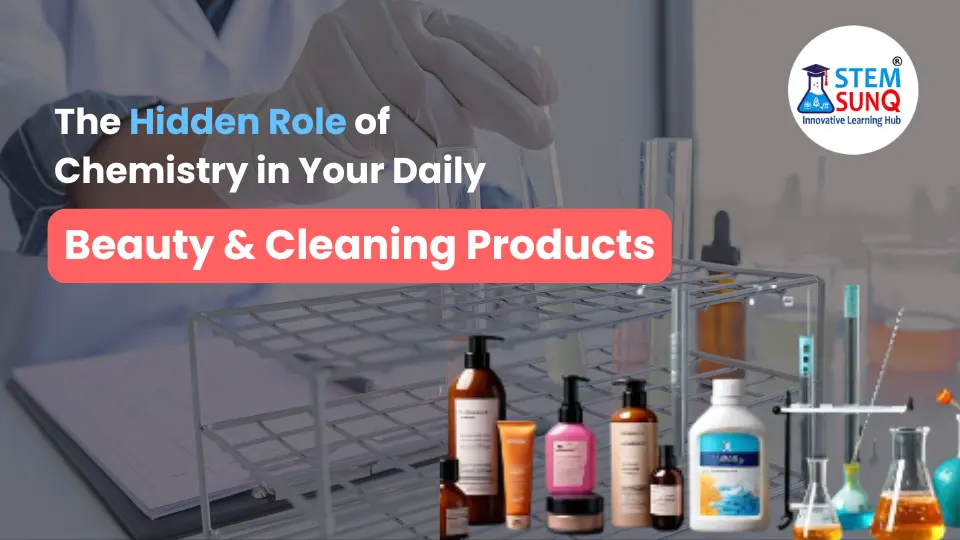
Table of Contents
Have you ever wondered what makes your shampoo lather just right or why your favorite moisturizer keeps your skin so soft? The answer lies in chemistry.
From the cosmetics we use to the cleaning supplies that keep our homes spotless, there is a hidden role of chemistry in your daily beauty and cleaning products.
Understanding the science behind these products not only helps us appreciate them more but also allows us to make better choices for our health and the environment.
Role of Chemistry in Your Daily Beauty and Cleaning Products
The Chemistry of Cosmetics
Let’s start with cosmetics. Every day, millions of people use products like lotions, makeup, and shampoos, but few realize the complex chemistry involved.
Lotions and Moisturizers: The primary goal of lotions and moisturizers is to keep our skin hydrated. This is achieved through a combination of water, oils, and emulsifiers. Emulsifiers are chemicals that help blend water and oil, creating a smooth, consistent product.
Common emulsifiers include substances like cetyl alcohol and polysorbates. Additionally, humectants like glycerin and hyaluronic acid attract water to the skin, ensuring long-lasting hydration.
Shampoos and Conditioners: Shampoos contain surfactants, which are chemicals that help remove dirt and oil from hair.
The most common surfactants are sulfates, such as sodium lauryl sulfate. While effective at cleaning, sulfates can sometimes be harsh on the scalp. That’s why many modern shampoos now include milder alternatives like Cocamidopropyl betaine.
Conditioners, on the other hand, contain cationic surfactants that neutralize the negative charges on hair strands, reducing static and making hair smoother.
Makeup: The chemistry of makeup is fascinating. Foundations and concealers often contain pigments mixed with a base of oil or water, while mascaras rely on polymers to coat and lengthen eyelashes.
Many makeup products also include preservatives to prevent the growth of bacteria and fungi, ensuring they remain safe to use over time.
The Chemistry of Cleaning Supplies
Moving from beauty to cleanliness, let’s delve into the chemistry of cleaning supplies. Whether it’s the detergent that washes our clothes or the disinfectant that cleans our kitchen counters, chemistry is at work.
Detergents: Laundry detergents combine surfactants, enzymes, and builders to effectively clean clothes.
Surfactants break up and remove dirt, enzymes break down protein and starch stains, and builders soften the water to improve the efficiency of the surfactants.
According to the American Cleaning Institute, enzymes in detergents can boost cleaning power and allow for lower washing temperatures, saving energy.
Disinfectants: Products like bleach and disinfectant sprays rely on chemicals to kill bacteria and viruses. Sodium hypochlorite, the active ingredient in bleach, is a powerful disinfectant that breaks down proteins in microorganisms, effectively killing them.
Other common disinfectants include quaternary ammonium compounds and alcohols, which disrupt the cell membranes of microbes.
All-Purpose Cleaners: These versatile products often contain a mix of surfactants, solvents, and chelating agents. Surfactants remove dirt, solvents like alcohol dissolve grease, and chelating agents bind to minerals in hard water, preventing streaks and residue.
The Impact of Chemistry on Health and Environment
Understanding the role of chemistry in these products also helps us consider their impact on health and the environment.
For instance, some surfactants and preservatives can cause skin irritation or allergic reactions in sensitive individuals.
Additionally, certain chemicals used in cosmetics and cleaning supplies can have environmental consequences. For example, phosphates in detergents can contribute to water pollution, leading to algal blooms that harm aquatic life.
Many companies are now turning to green chemistry to create safer, more sustainable products. Green chemistry focuses on designing products and processes that minimize the use and generation of hazardous substances.
This can include using plant-based surfactants, biodegradable polymers, and natural preservatives.
Conclusion: The Everyday Marvel of Chemistry
Next time you use your favorite shampoo or clean your kitchen counter, take a moment to appreciate the chemistry behind these everyday products.
From making our hair shiny to keeping our homes clean, chemistry plays a crucial role in enhancing our daily lives.
By understanding the science behind these products, we can make more informed choices that benefit both our health and the environment.
Chemistry isn’t just something that happens in a lab; it’s a part of our everyday life, making it more convenient, efficient, and enjoyable.






